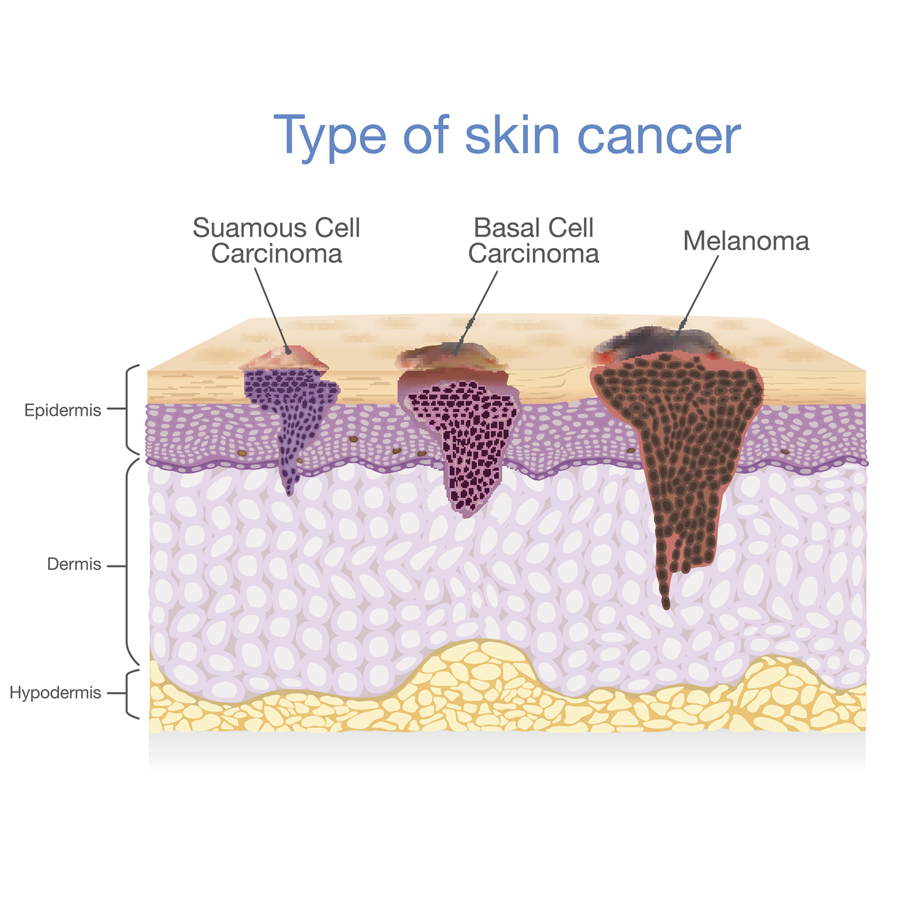Cancer occurs when damage to DNA causes genetic changes or mutations that lead to uncontrolled cell division. Cancer is caused by agents known as carcinogens, which cause DNA damage to cells. Like tobacco, UV radiation from the sun or tanning beds is considered a carcinogen because the damage it does to the DNA inside skin cells can lead to cancer. The body repairs much of the
damaged DNA, but some damage will remain, especially with repeated exposure to UV radiation.
Skin cancer is the most common type of cancer in the world with ~ 3 million new cases of skin cancer are diagnosed in the US yearly. There are two main types of skin cancer, non-melanoma skin cancer (NMSC) and melanoma. NMSC are much more common than Melanoma, but Melanoma are more deadly. Basal Cell Carcinoma (BCC) or Squamous Cell Carcinoma (SCC) are most common type of NMSC. NMSC are caused by the abnormal growth of skin stem cells in the epidermis due to exposure to harmful levels of UV that lead to the accumulation of DNA Damage induced genetic changes or mutations. This abnormal growth can, in turn, cause the skin cells to multiply rapidly and form tumors. This process takes many years to happen, but persistent sun damage to skin can accelerate cancer formation. Similarly, Melanocytes in the skin can become damaged and accumulated mutations that promote their transformation into melanoma.
The primary causes of skin cancer can be attributed to the sun’s harmful UV radiation and the use of artificial tanning devices. Luckily, if a skin cancer is found early, dermatologists can treat it with little scarring and good chances of eliminating it completely. If you keep up with your preventative skin screenings, your dermatologist may even detect a lesion at a precancerous stage before it has become an advanced skin cancer or invaded the deeper layers of the skin.
What Role Do Genetics Play in Skin Cancer Risks?
As with many other conditions, genetics may play a role in a person’s chances of developing skin cancer. Nearly all cases of skin cancer are due to environmental factors rather than genetics; however, skin cancer is still genetic in that it involves some degree of inherited risk.
In the case of Melanoma, inherited risk factors seem to play a larger role. About 5 to 10% of melanoma cases are inherited in an autosomal dominant fashion. In other words, parents with a defined genetic mutation have a 50/50 chance to pass on the susceptibility to each of their children regardless of gender.
-Stanford Health
Like the ABCDE's, an Ugly Duckling can also be a warning sign of melanoma. This approach is based on the idea that most of the regular moles on your body look like each other. Melanomas, on the other hand, stand out like ugly ducklings when compared to their neighbors.
When compared to surrounding moles, ugly ducklings can be larger, smaller, lighter, or darker. Additionally, moles without any neighbors may also be considered ugly ducklings. Check out some examples of Ugly Ducklings above.











